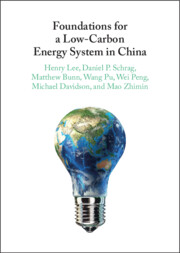Book contents
- Foundations for a Low-Carbon Energy System in China
- Foundations for a Low-Carbon Energy System in China
- Copyright page
- Contents
- Acknowledgments
- 1 Introduction
- 2 Reforming China’s Electricity Market to Facilitate Low-Carbon Transition
- 3 Promoting Large-Scale Deployment and Integration of Renewable Electricity
- 4 Enabling a Significant Nuclear Role in China’s Decarbonization
- 5 Transitioning to Electric Vehicles
- 6 From Barrier to Bridge
- 7 Coordinating Strategies to Reduce Air Pollution and Carbon Emissions in China
- 8 Conclusion
- Index
- References
3 - Promoting Large-Scale Deployment and Integration of Renewable Electricity
Published online by Cambridge University Press: 02 December 2021
- Foundations for a Low-Carbon Energy System in China
- Foundations for a Low-Carbon Energy System in China
- Copyright page
- Contents
- Acknowledgments
- 1 Introduction
- 2 Reforming China’s Electricity Market to Facilitate Low-Carbon Transition
- 3 Promoting Large-Scale Deployment and Integration of Renewable Electricity
- 4 Enabling a Significant Nuclear Role in China’s Decarbonization
- 5 Transitioning to Electric Vehicles
- 6 From Barrier to Bridge
- 7 Coordinating Strategies to Reduce Air Pollution and Carbon Emissions in China
- 8 Conclusion
- Index
- References
Summary
Increasing the scale of renewable integration is a key component of China’s decarbonization strategy. While the immediate challenge is to reduce renewable curtailment and increase its penetration, mitigating climate change in the long term will require a transition from an electricity system dominated by coal to one that consists primarily of renewables. This chapter summarizes the current governance structure and policies for renewable energy development and integration in China. It identifies two key considerations for China to transition towards large-scale penetration of renewables: geographic mismatch between renewable resources and demand centers, and concerns associated with integrating high penetration of intermittent renewable energy resources. Responding to these considerations, this chapter discusses four foundational elements that China needs to put in place in the near term to plan for the longer-term transition: flexible conventional generators, an appropriately large and more integrated transmission network, storage technology development, and demand-side flexibility/responsiveness.
Keywords
- Type
- Chapter
- Information
- Foundations for a Low-Carbon Energy System in China , pp. 39 - 64Publisher: Cambridge University PressPrint publication year: 2021



